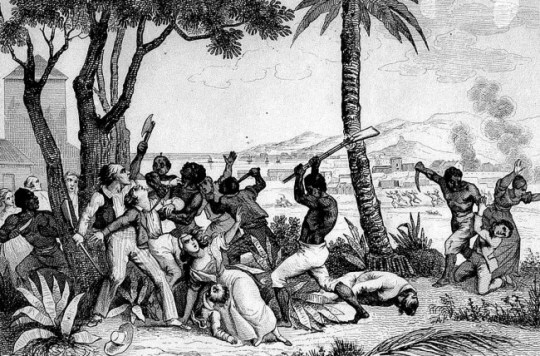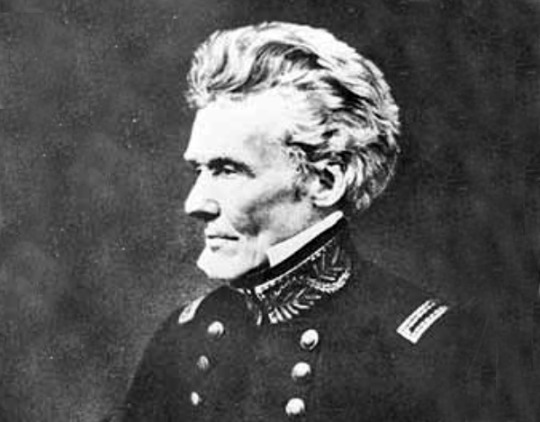#The Battle of ‘Negro Fort’ – Inside America's Forgotten Slave Rebellion
Text
The Battle of ‘Negro Fort’ – Inside America's Forgotten Slave Rebellion - MilitaryHistoryNow.com

A year after the Battle of New Orleans, runaway slaves armed by the British occupied a stockade in Spanish Florida. The so called “Negro Fort” became a mecca for other fugitives from Southern plantations. In 1816, the U.S. Army arrived to crush the settlement. (Image source: WikiCommons)
“The Battle of the ‘Negro Fort,’ marks a critical moment when the federal government took a decisive stance in support of slavery and its expansion.”
By Matt Clavin
THE TIDAL MARSHES of Florida’s Apalachicola River were still under the authority of the Spanish crown in 1816, yet the events that took place there would go on to become a forgotten yet tragic chapter in the long and bloody history of American slavery.
It was during that year that an army of fugitive slaves, armed with foreign weaponry and united by dreams of freedom, would fight and die against a legion of American troops and allied Creek Indians dispatched by a future U.S. president bent on their destruction.
The Battle of the ‘Negro Fort’ marks a critical moment when the federal government took a decisive stance in support of slavery and its expansion.
What would become known as Negro Fort actually sprung from the War of 1812, one of the United States’ most misunderstood conflicts. During the contest’s third and final summer, Britain landed hundreds of troops on Florida’s Gulf Coast in preparation of an invasion of the southern United States.

Still Spanish territories at the time, East Florida and West Florida were neutral in the second war between the American Republic and the United Kingdom. Yet, the uncontested arrival of British troops there suggested the local authorities had ostensibly sided with the redcoats.
Americans’ fears of a Spanish-British alliances only increased when a detachment of Royal Marines erected a sizeable fort on the eastern shore of the Apalachicola River in the Florida Panhandle. Commanders of the new outpost then called upon Native Americans and fugitive African American slaves from across the region to join the British at the fort and together take up arms against the United States. Eventually, more than a thousand Creek, Choctaw, and Seminole Indians, along with several hundred runaways from southern plantations, accepted the invitation.

Following the final ratification of the Treaty of Ghent in the spring of 1815, the British withdrew their forces from Florida. With their powerful allies suddenly gone, most of the Indians gathered at the Apalachicola fort returned to their homes. But the hundreds of fugitive slaves inside the stockade had no place to go and so remained at the abandoned British post. And with the fort’s massive earthworks, wooden palisades and stone buildings at their disposal, along with an arsenal of hundreds of muskets, swords, bayonets and dozens of cannon, the runaways chose to remain there come what may.

Under an informal system of government that can best be described as martial law, this militant black community organized daily for its defence. At the same time, it established important relationships with the neighbouring Choctaws, Creeks, and Seminoles, who provided food and other sustenance in return for weapons and ammunition.
Negro fort was, in a word, formidable.
One British officer who, following the Treaty of Ghent, set out to assist some of the fugitive’s former owners regain their valuable property offered a curt assessment of fort’s inhabitants.
“The blacks are very violent & say they will die to a man rather than return.”

In the coming weeks and months, Hawkins and a number of prominent frontier citizens and officials flooded Washington with reports of rebellious slaves and their savage Indian allies running wild across the southern frontier. The accounts were almost entirely exaggerated.
Although clashes between Indians and settlers on disputed lands throughout the American south were commonplace in the early 19th Century, aside from inspiring an exodus of fugitive slaves from the southern states into Florida, the Negro Fort posed no threat to the United States.
None of this stopped the commander of the United States’ southern army, General Jackson, from taking bold and aggressive action against the settlement.

Through a careful and calculating correspondence, Jackson ordered General Edmund Gaines, a hero of the War of 1812, invade Florida with 100 regulars, destroy the fort and return all of its black inhabitants to their American and Spanish owners. To ensure an American victory with as few friendly casualties as possible, Jackson secured the assistance of hundreds of Creek warriors by promising them a cash reward of as much as $50 dollars a head for every black slave returned to captivity.

Over the course of the next two weeks, hundreds of pro-American Creek warriors clashed with black rebels in the dense woods surrounding the fort, which at times descended into bloody hand-to-hand combat.
With American troops watching from a safe distance, the number of casualties went unrecorded—though it must have been considerable.
When a failed sortie by the fort’s defenders was repulsed, an American eyewitness suspected it was only a ruse.
“Many circumstances convinced us,” army doctor Marcus Buck wrote to his father, “that most of them determined never to be taken alive.”
With a pause in the ground fighting, American army and navy vessels on the river exchanged cannonfire with the fort’s defenders for several days.
The bombardment continued to the morning of July 27, when a heated cannonball, or “hotshot,” fired from U.S. Gunboat 154 flew over walls of Negro Fort’s massive inner citadel, landing directly on a gunpowder magazine.

The response of American officials to the destruction of Negro Fort was muted, largely because the entire campaign was illegal. After all, with neither congressional nor executive authority, the United States armed forces had invaded a foreign territory.
By contrast, southern slave owners hailed the battle’s outcome as the dawning of a new day. A Georgia writer expressed this view when reporting “the capture of the Negro and Indian Fort, on Apalachicola.” He explained that because of the efforts of his “brave countrymen,” the southern and western frontiers were now free of the “predatory incursions” posed by black and Indian bandits “whose numbers were daily augmenting; and whose strength and resources presented a fearful aspect to our peaceful borders.”

Within two years of the Battle of Negro Fort, Jackson and the American army again invaded Florida. The resulting First Seminole War would be the first of three wars between the United States and Florida’s black and Indian population who simply refused to submit to their northern American neighbours.
Though Negro Fort survived for only a year, its memory endured in the hearts and minds of hundreds of its inhabitants who had abandoned the outpost prior to its destruction. By fleeing to the Florida peninsula and aligning with the Seminole Indians, most of these former slaves carved out difficult but free lives on the outer edges of the American republic.
As many as one hundred of them were even more fortunate, finding not only freedom but peace and tranquility in the West Indies. By boarding trading vessels and escaping to the Bahama Islands several years after the Battle of Negro Fort, they completed the improbable journey from American slaves to British subjects.
#The Battle of ‘Negro Fort’ – Inside America's Forgotten Slave Rebellion#florida#negro fort#negro abraham#Freedmen#seminole indians#florida enslaved#history of slave settlements in florida
10 notes
·
View notes